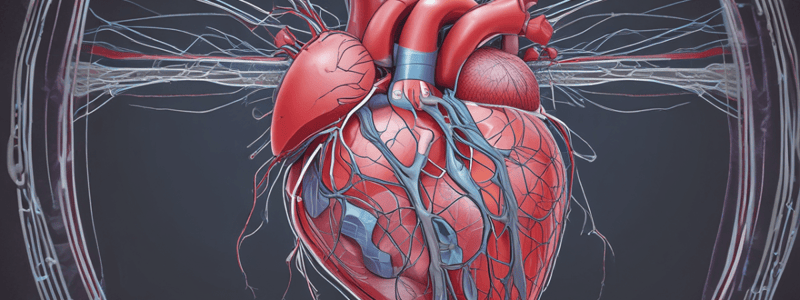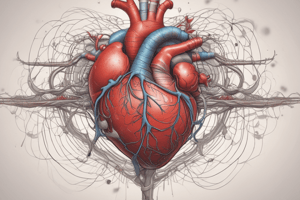Podcast
Questions and Answers
What is the main function of the heart in the human body?
What is the main function of the heart in the human body?
The main function of the heart is to pump blood throughout the body.
What is the purpose of the septum in the heart?
What is the purpose of the septum in the heart?
The septum is a thin wall of tissue that separates the right and left sides of the heart.
Which valve is located between the left atrium and ventricle?
Which valve is located between the left atrium and ventricle?
The mitral valve is located between the left atrium and ventricle.
What is the difference between arteries and veins?
What is the difference between arteries and veins?
What is the purpose of arterioles in the circulatory system?
What is the purpose of arterioles in the circulatory system?
What is the sequence of blood flow through the pulmonary circulation?
What is the sequence of blood flow through the pulmonary circulation?
What is the main function of capillaries in the circulatory system?
What is the main function of capillaries in the circulatory system?
What is the difference between systemic and pulmonary circulation?
What is the difference between systemic and pulmonary circulation?
What is the primary function of the right atrium in the heart?
What is the primary function of the right atrium in the heart?
What is the main characteristic of the walls of arteries that allows them to withstand high pressure?
What is the main characteristic of the walls of arteries that allows them to withstand high pressure?
What is the primary function of the pulmonary valve in the heart?
What is the primary function of the pulmonary valve in the heart?
What is the role of venules in the venous circulation?
What is the role of venules in the venous circulation?
How does the respiratory pump assist in venous return?
How does the respiratory pump assist in venous return?
What is the primary function of the aortic valve in the heart?
What is the primary function of the aortic valve in the heart?
What is the role of capillaries in the exchange of oxygen and nutrients with the tissues?
What is the role of capillaries in the exchange of oxygen and nutrients with the tissues?
What is the effect of arteriole constriction on blood pressure?
What is the effect of arteriole constriction on blood pressure?
Flashcards
What is the heart?
What is the heart?
A muscular, hollow organ that pumps blood throughout the body.
What are the functions of the atria?
What are the functions of the atria?
The right atrium receives oxygen-depleted blood from the body, while the left atrium receives oxygen-rich blood from the lungs.
What are the functions of the ventricles?
What are the functions of the ventricles?
The right ventricle pumps oxygen-depleted blood to the lungs, while the left ventricle pumps oxygen-rich blood to the rest of the body.
What is the septum?
What is the septum?
Signup and view all the flashcards
What is the function of heart valves?
What is the function of heart valves?
Signup and view all the flashcards
What is the function of arteries?
What is the function of arteries?
Signup and view all the flashcards
What is the function of veins?
What is the function of veins?
Signup and view all the flashcards
What are capillaries?
What are capillaries?
Signup and view all the flashcards
What is pulmonary circulation?
What is pulmonary circulation?
Signup and view all the flashcards
What is systemic circulation?
What is systemic circulation?
Signup and view all the flashcards
What is blood pressure?
What is blood pressure?
Signup and view all the flashcards
What is heart rate?
What is heart rate?
Signup and view all the flashcards
What is cardiac output?
What is cardiac output?
Signup and view all the flashcards
What are the types of arteries?
What are the types of arteries?
Signup and view all the flashcards
What are the types of veins?
What are the types of veins?
Signup and view all the flashcards
Study Notes
Heart Structure
- The heart is a muscular, hollow organ that pumps blood throughout the body
- Composed of four chambers:
- Right atrium (receives oxygen-depleted blood from the body)
- Right ventricle (pumps oxygen-depleted blood to the lungs)
- Left atrium (receives oxygen-rich blood from the lungs)
- Left ventricle (pumps oxygen-rich blood to the rest of the body)
- Septum: a thin wall of tissue that separates the right and left sides of the heart
- Valves: ensure blood flows in one direction through the heart
- Tricuspid valve: between right atrium and ventricle
- Pulmonary valve: between right ventricle and pulmonary artery
- Mitral valve: between left atrium and ventricle
- Aortic valve: between left ventricle and aorta
Blood Vessels
- Arteries: carry oxygen-rich blood away from the heart
- Elastic arteries: stretchy, pulsatile arteries (e.g. aorta)
- Muscular arteries: less stretchy, more muscular arteries (e.g. femoral artery)
- Arterioles: small, resistive arteries that regulate blood flow
- Veins: carry oxygen-depleted blood back to the heart
- Venules: small, low-pressure veins that collect blood from capillaries
- Medium-sized veins: return blood to the heart
- Large veins: return blood to the heart, often with one-way valves to prevent backflow
- Capillaries: tiny, thin-walled vessels where oxygen and nutrient exchange occurs
Blood Circulation
- Pulmonary circulation: oxygen-depleted blood from the heart to the lungs and back to the heart
- Systemic circulation: oxygen-rich blood from the heart to the rest of the body and back to the heart
- Blood flows through the following sequence:
- Heart → pulmonary artery → lungs → pulmonary veins → heart
- Heart → aorta → arteries → arterioles → capillaries → venules → veins → heart
Other Key Components
- Blood pressure: the force of blood pushing against blood vessel walls
- Heart rate: the number of times the heart beats per minute
- Cardiac output: the volume of blood pumped by the heart per minute
Heart Structure
- Heart is a muscular, hollow organ that pumps blood throughout the body
- Composed of four chambers: right atrium, right ventricle, left atrium, and left ventricle
- Septum: a thin wall of tissue that separates the right and left sides of the heart
- Valves ensure blood flows in one direction through the heart: tricuspid, pulmonary, mitral, and aortic valves
Blood Vessels
- Arteries carry oxygen-rich blood away from the heart: elastic, muscular, and arterioles
- Veins carry oxygen-depleted blood back to the heart: venules, medium-sized, and large veins
- Capillaries: tiny, thin-walled vessels where oxygen and nutrient exchange occurs
Blood Circulation
- Pulmonary circulation: heart to lungs and back to heart
- Systemic circulation: heart to rest of body and back to heart
- Blood flows through the sequence: heart → pulmonary artery → lungs → pulmonary veins → heart, then heart → aorta → arteries → arterioles → capillaries → venules → veins → heart
Other Key Components
- Blood pressure: force of blood pushing against blood vessel walls
- Heart rate: number of times the heart beats per minute
- Cardiac output: volume of blood pumped by the heart per minute
Heart Structure
- Located in the thoracic cavity, between the lungs
- Divided into four chambers: right atrium, left atrium, right ventricle, and left ventricle
- Right atrium receives deoxygenated blood from the body, while left atrium receives oxygenated blood from the lungs
- Right ventricle pumps deoxygenated blood to the lungs, and left ventricle pumps oxygenated blood to the body
- Septum is a thin wall of tissue that separates the right and left sides of the heart
- Valves include tricuspid, pulmonary, mitral, and aortic valves, which prevent backflow and ensure proper blood flow
Blood Vessels
- Arteries carry oxygenated blood away from the heart, with thick walls to withstand high pressure
- Veins carry deoxygenated blood back to the heart, with thinner walls and less pressure
- Capillaries are tiny vessels where oxygen and nutrients are exchanged with the tissues, with walls only one cell layer thick
Arterial Circulation
- Pulmonary circulation involves deoxygenated blood from the heart to the lungs, via pulmonary arteries, arterioles, and capillaries
- Systemic circulation involves oxygenated blood from the heart to the body, via the aorta, arteries, arterioles, and capillaries
- Arterioles regulate blood pressure by constricting or dilating, and control blood flow to specific areas of the body
Venous Circulation
- Pulmonary veins carry oxygenated blood from the lungs to the heart
- Systemic veins carry deoxygenated blood from the body to the heart
- Venules merge to form larger veins, which return to the heart
- Venous return is assisted by the skeletal muscle pump and respiratory pump, with increased pressure in the chest cavity during inhalation helping to push blood back to the heart
Studying That Suits You
Use AI to generate personalized quizzes and flashcards to suit your learning preferences.



